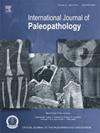Expanding the diagnostic scope of paleopathology: Identification of Q fever (Coxiella burnetii) using a One Paleopathology approach
IF 1.5
3区 地球科学
Q3 PALEONTOLOGY
引用次数: 0
Abstract
Objectives
This project is an application of the One Paleopathology approach to the study of Q fever (C. burnetii infection), a disease which is underdiagnosed and largely unknown in paleopathology.
Materials
Clinical and veterinary pathological case reports and reviews, bioarcheological and zooarchaeological data, veterinary and environmental studies of wild and domestic animal pathology, clinical molecular pathogen data
Methods
One Paleopathology approach which combines data from people, animals, and their environment to understand disease in the past.
Results
Q fever in animals presents as reproductive failure, with no typical skeletal manifestations seen in animals. Persistent Q fever (C. burnetii) focalized infection affects the human skeleton in predictable ways, including spondylodiscitis and extravertebral osteomyelitis or osteitis which can occur more commonly in children. Evidence of skeletal involvement suggests C. burnetii infection in the past is underestimated and underdiagnosed in humans.
Conclusion
Using the One Paleopathology approach can improve the study of C. burnetii infection in the past, where both animal and human paleopathology and environmental factors are assessed in developing potential diagnoses.
Significance
This project is the first paleopathological study to specifically focus awareness on identification of C. burnetii in past skeletal samples, both animal and human.
Limitations
Lack of paleopathological studies and existing reference literature identifying skeletal involvement associated with C. burnetii infection.
Suggestions for future research
Future paleopathological genomic studies should focus on identification of C. burnetii genotypes.
扩大古病理学的诊断范围:使用 "一种古病理学方法 "鉴定 Q 热(烧伤柯西氏杆菌)。
目的:本项目是将 "一个古病理学 "方法应用于 Q 热(烧伤蜱感染)研究:本项目是将 "一种古病理学方法 "应用于 Q 热(烧伤弧菌感染)的研究,这种疾病诊断不足,在古病理学中基本上不为人所知:材料:临床和兽医病理病例报告和综述、生物考古学和动物考古学数据、兽医和环境对野生和家养动物病理学的研究、临床分子病原体数据 方法:"一个古病理学 "方法,结合人、动物及其环境的数据来了解过去的疾病:动物的 Q 热表现为生殖衰竭,没有典型的骨骼表现。持续性 Q 热(C. burnetii)灶性感染会以可预测的方式影响人类骨骼,包括脊柱盘炎和椎体外骨髓炎或骨炎,这在儿童中更为常见。骨骼受累的证据表明,过去烧伤桿菌感染在人类中被低估和诊断不足:结论:使用 "一种古病理学 "方法可以改进对过去烧伤弧菌感染的研究,在研究潜在诊断时可对动物和人类古病理学及环境因素进行评估:该项目是第一项特别关注在过去的动物和人类骨骼样本中识别烧伤弧菌的古病理学研究:局限性:缺乏古病理学研究和现有参考文献来确定与烧伤桿菌感染相关的骨骼受累情况:未来研究建议:未来的古病理学基因组研究应侧重于识别烧伤桿菌的基因型。
本文章由计算机程序翻译,如有差异,请以英文原文为准。
求助全文
约1分钟内获得全文
求助全文
来源期刊

International Journal of Paleopathology
PALEONTOLOGY-PATHOLOGY
CiteScore
2.90
自引率
25.00%
发文量
43
期刊介绍:
Paleopathology is the study and application of methods and techniques for investigating diseases and related conditions from skeletal and soft tissue remains. The International Journal of Paleopathology (IJPP) will publish original and significant articles on human and animal (including hominids) disease, based upon the study of physical remains, including osseous, dental, and preserved soft tissues at a range of methodological levels, from direct observation to molecular, chemical, histological and radiographic analysis. Discussion of ways in which these methods can be applied to the reconstruction of health, disease and life histories in the past is central to the discipline, so the journal would also encourage papers covering interpretive and theoretical issues, and those that place the study of disease at the centre of a bioarchaeological or biocultural approach. Papers dealing with historical evidence relating to disease in the past (rather than history of medicine) will also be published. The journal will also accept significant studies that applied previously developed techniques to new materials, setting the research in the context of current debates on past human and animal health.
 求助内容:
求助内容: 应助结果提醒方式:
应助结果提醒方式:


